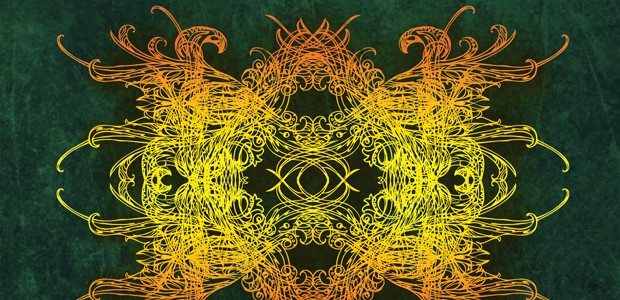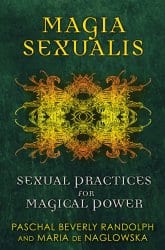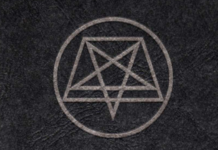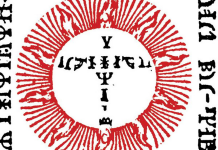
 Magia Sexualis: Sexual Practices for Magical Power, by Paschal Beverly Randolph and Maria de Naglowska, translated by Donald Traxler
Magia Sexualis: Sexual Practices for Magical Power, by Paschal Beverly Randolph and Maria de Naglowska, translated by Donald Traxler
Inner Traditions, 9781594774188, 174 pp. (incl. notes, bibliography, and index), 2012
Paschal Beverly Randolph‘s Magia Sexualis has often been called the most influential book about sex magick ever written. It survives through Maria de Naglowska‘s French translation and adaptation in an edition of 1,007 copies published more than 50 years after Randolph’s death.
Pashal Beverly Randolph (1825-1875) was an African American doctor, and the occultist who introduced sex magick to North America. He began his studies with the Hermetic Brotherhood of Luxor, and went on to author several books, founded the Brotherhood of Eulis, became a Rosicrucian, and was a rival of Helena Petrovna Blavatsky. The Brotherhood of Eluis was an initiating group, which sought to examine “occult data in the light of contemporary science.”1
By the end of her life, Maria de Naglowska (1883-1936), a journalist, writer, and translator, was said to have spoken 10 languages. She also authored several books, and founded the Brotherhood of the Golden Arrow. She called herself a Satanist, and gave lectures on sex magick and occult matters in Paris in the 1930s. (See also our reviews of her earlier books: The Light of Sex, Advanced Sex Magic, and The Sacred Rite of Magical Love.)
Donald Traxler notes that Naglowska’s translation of Magia Sexualis is not so much a translation as a compilation of Randolph’s work (he puts the word “translation” in quotes), writing that “While the greater part of the content can be traced to known works of Randolph, a very significant portion cannot.”2 He also credits Naglowska with organizing and smoothing out the language.
If a complete text from Randolph exists in English, it hasn’t been found. Since Naglowska’s original translation, other editions have appeared, of course — in French, Italian (translated by Julius Evola), and in English in an edition published by Magickal Childe (translated by Robert North) — though Donald Traxler‘s version closer adheres to Naglowska’s, and, as always, his preface and notes help contextualize Maria de Naglowska’s life and work, and in this case, Paschal Beverly Randolph’s as well.
In the preface to Naglowska’s translation, she writes that Randolph is the first to “proudly proclaim that they key to all the mysteries of the Universe is to be found in Sex.”3 Randolph’s introduction outlines his spiritual philosophies, and the ideas held sacred by the Brotherhood of Eulis in the Mysteries of Eulis and Ansairetic Mysteries. They’re what you’d expect: heteronormative, procreation is deemed “the greatest miracle of Nature,” the “currents” that resonate in the body depend on a polarity that functions similar to a battery, and the ways this pertains to Randolph’s sex magick, and so on. For instance, in Randolph’s system, women are the active principle in mind and the negative in body, whereas men are the negative principle in mind and the active in body.4 No consideration is given to intersex people, those whose body and mind may not align in the way described, or those who may not be engaging in heterosexual sex.
The rigid fixation on an outdated idea of gender binary and the heterosexist unions described may not fit with today’s more diverse and inclusive stance on gender and sexuality, but it’s fascinating to see how Randolph and Naglowska portray them, and from this, you can see the influences these ideas had on later sex magicians, such as Aleister Crowley, who has written praise to both of them for their works. It’s easy to see vestiges of this in today’s Ordo Templi Orientis as well.
Randolph recommends the study and development of three primary disciplines: “volenta,” a manifestation of concentration; “decretism,” a manifestation of directing will; and “posism,” a manifestation of gesture, or poses. Each is only capable once the previous has been mastered. Once these three have been fully developed, one can practice “tiracularism,” the power of evocation. Many magicians create their own lexicons when describing their understanding of how magick works and its practice, but Traxler notes that Randolph’s neologisms seem to take it to a new level. It’s interesting to see that, despite Magia Sexualis‘ overwhelming influence on sex magick, many of his terms were not adopted into common use among occultists.
There are complex charts that detail tables of correspondences, listing planets, scales, numbers, colours, scents and plants, stones, and notes on how to determine one’s strengths or weaknesses based on this. From these charts one can determine one’s personal mudras, mantras, melody, and colour. Magical sexual operators are to use these charts to achieve a range of diverse goals.
Unlike some later magicians, again, such as Aleister Crowley, Randolph believes that the operator’s partner (he assumes a male magician working with a woman, but allows that the roles might be reversed) must be aware of what’s taking place, and possess “high morals.” He recommends that the magician, “not take, for the magical operation, either a prostitute, or an inexperienced virgin, or a minor under the age of eighteen years, or another’s wife; but accomplish the solemn act with your wife, or your lover.”5 It’s a refreshing change. As is his recommendation that “the man should never touch a woman who is not excited, and he must not leave her before both orgasms have passed.”6 Again, sensible, but surprisingly this is often overlooked, even in more contemporary texts.
Diagrams are given for recommended sexual positions which, again, assume a male operator, though Randolph says the positions can be reversed for women magicians “according to the law of natural analogies.”7 Though some of these can only be done with sexual aids, which he doesn’t mention.
Numerous recipes and rites are given for charging “volts,” creating “fluid condensers,” and magical rings (in two designs) intended to hold specific fluids. A planetary chart is given for planetary charges, complementary and non-, along with projecting charges. A treatise on magical mirrors is given, originally from an earlier work of Randolph’s, Seership!, which includes various recipes and formulae for constriction which are not found in other publicly available editions of his work, and may have been privately printed or adapted by Naglowska.
Perhaps the oddest part of this book might be the directions to create a “living tableaux,” intended to bring to life paintings and statues. An “Extract of the Testament of Our Brother Charsah” is given as proof of its efficacy, yet it states, “We recommend to the student who is not sufficiently sure of himself that he get the help of a psychologist.”8 The methods given are sufficiently complicated that few are likely to attempt it, in any case.
Magia Sexualis is a fascinating piece of occult history detailing Victorian-era beliefes and practices. Informed by Hermetic Brotherhood of Luxor, intended for Brotherhood of Eulis, these writings have influenced post-Blavatasky Theosophists, Aleister Crowley, and modern sex magick in profound ways. Magia Sexualis is essential reading for anyone interested in the history and development of sex magick.








